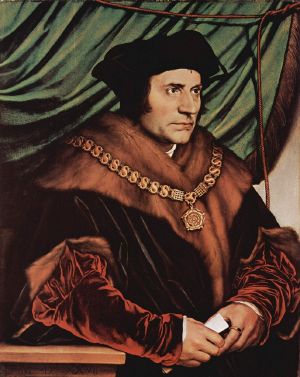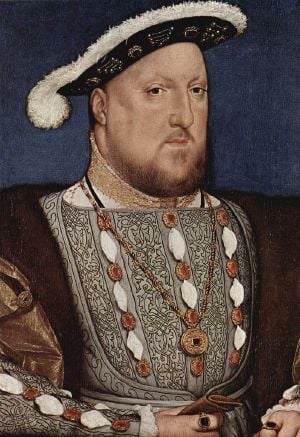Hans Holbein the Younger
Hans Holbein the Younger (c. 1497– before November 29, 1543) was a German artist and printmaker who worked in a Northern Renaissance style in Basel, Switzerland and London, England. He is best known for his many portraits of English nobility and his series of 41 woodcuts, known as the Dance of Death.
A friend of the famous Dutch humanist Erasmus, Holbein illustrated the writer's satire, The Praise of Folly. He also illustrated several other books, including Martin Luther’s German translation of the Bible. He also designed stained glass windows and painted murals. In 1526 he traveled to England where he painted Sir Thomas More.
When the Protestant Reformation reached Basel and forced the curtailment of religious art, Holbein moved permanently to England, where he became a painter for the court of King Henry VIII, leaving many famous portraits. He painted over 100 portraits and miniatures and designed numerous items for the court, including the king's royal robes. Holbein died of the plague in London in 1543. He is considered one of art history's greatest and most influential portrait artists.
Early life and career
Holbein was born in Augsburg, Bavaria and learned painting from his father, Hans Holbein the Elder. Like his father, he designed stained glass windows and painted portraits.
Later, he went with his brother Ambrosius Holbein to Basel where he met many scholars, among them the Dutch humanist Erasmus of Rotterdam. His drawings from this time provide early evidence of Holbein's wit and humanistic leanings. His other early works, including the double portraits of Basel's mayor Jakob Meyer zum Hasen and his wife Dorothea Kannengiesser, follow the style of his father. Holbein was asked by Erasmus to illustrate his famous satire The Praise of Folly, published in 1515. He also illustrated several other books, including Martin Luther's translation of the German Bible.
Holbein visited Italy in 1517 and France in 1524, where his skill was influenced by the artists there. He joined the painters’ guild in 1519 and married a tanner’s widow, becoming a burgher of Basel in 1520. By 1521 he was painting important murals in the town hall of Basel.
His most famous work of the time was a series of 41 scenes (woodcuts), known as the Dance of Death, illustrating the medieval allegorical concept of Death. He designed these works between 1523 and 1526. Another artist, Hans Lützelburger, cut them and they were not published until 1538. These striking scenes reveal not only a deep sense of order but also many distinct details about the habits of Death’s victims. Holbein also painted many large religious works between 1520 and 1526, including the Oberried Altarpiece, the Solothurn Madonna, and The Passion.
The year 1526 witnessed iconoclastic riots and censorship of the press sweeping over the city of Basel. As a result of the reformers' antagonism toward religious art, Holbein's freedom and income as a religious painter suffered. Holbein seems to have given up all painting of religious art after 1530.
Holbein in England


When the strife of the Reformation made it difficult for Holbein to support himself as an artist in Basel, he set out for London in 1526 where he worked for two years. Erasmus furnished him with a letter of introduction addressed to the English statesman and author Sir Thomas More. He painted portraits of More and a full size one of his family, thus gaining a good reputation in England as a portraitist.
When Holbein returned to England again in 1532-43, he became a court painter and produced many portraits at the court of Henry VIII. He painted a full-size portrait of Henry, which astonished the court, and numerous people remarked that it seemed "alive" with the head and limbs seemingly to move as the viewer passed by.
Holbein's commissions in the early stages of his second English period included portraits of Lutheran merchants of the Hanseatic League, who lived and worked in a complex of warehouses, offices, and dwellings on the north bank of the Thames. Holbein himself rented a house in Maiden Lane nearby. He painted two monumental allegories, The Triumph of Wealth and The Triumph of Poverty. He portrayed the merchants in a range of styles: his portrait of Georg Gisze of Danzig shows him surrounded with symbols of his trade, painted in exquisite detail; his portrait of Derich Berck of Cologne, on the other hand, is classically simple, seemingly influenced by Titian.
Holbein also portrayed various courtiers, landowners, and visitors during this time. His most famous, and perhaps greatest, painting of this period was The Ambassadors, a life-sized double portrait of Jean de Dinteville, an ambassador of Francis I of France, and of Georges de Selve, Bishop of Lavaur, painted in 1533-34. The painting incorporates symbols and paradoxes which encode enigmatic references to learning, religion, mortality, and illusion, in the tradition of the Northern Renaissance.
For King Henry VIII, he designed official state robes, as well as many household items, from buttons and bridles to book-bindings and broaches. He also designed many of the extravagant monuments and decorations for the coronation of Henry's second wife, Anne Boleyn, in the summer of 1533. He contributed much to the colorful period of art of the court and his works are seen as an historical document of the culture of the court.
Several extant drawings said to be of Anne Boleyn are attributed to Holbein. One portrays a woman with rather plump features dressed in a plain nightgown. Some have said that this shows the queen during pregnancy, sometime between 1533 and 1535, but recent research suggests that the subject is actually one of Anne's ladies-in-waiting, possibly Lady Margaret Lee or one of her sisters. It seems more likely that the portrait Holbein made of Anne Boleyn was destroyed after she was beheaded in 1536 on charges of treason, adultery, incest and witchcraft.

Holbein also painted Henry's third wife, Jane Seymour, as well as Jane's sister, Elizabeth Seymour, who married the son of Thomas Cromwell. This portrait was incorrectly identified as Henry's fifth wife, Queen Catherine Howard, when it was discovered in the Victorian era. After Seymour's death, Holbein painted Christina of Denmark during negotiations for her prospective marriage to Henry VIII. The likeness met with Henry's approval, but Christina declined the offer of matrimony, citing a desire to retain her head.
Holbein also painted Anne of Cleves for Henry as a prelude to his proposal of marriage. Henry famously criticized the portrait later as having been too flattering. There is some debate over whether or not a portrait miniature of a young woman in a gold dress and jewel is in fact Holbein's painting of Henry's fifth wife, Catherine Howard.
Holbein died while working on another portrait of Henry in London. He made his will on October 7, 1543, and a document attached to it, dated November 29, describes him as recently dead.[1]
Portrait techniques

For Holbein, art begins with drawing. A gifted draftsman, he was heir to a German tradition of line drawing and precise preparatory design. As his career progressed, he added Italian Renaissance motifs to his Gothic vocabulary. Throughout his life, Holbein designed for both large-scale art-works and smaller objects. In many cases, his designs, or copies of them, are the sole evidence for such works. For example, his murals for the Hertenstein House in Lucerne and for the House of the Dance in Basel are known only through his drawings and designs.
Holbein always made highly detailed pencil drawings of his portrait subjects, often supplemented with ink and colored chalk. The drawings emphasize facial detail and usually did not include the hands; clothing was only indicated schematically. The outlines of these drawings were then transferred onto the support for the final painting using tiny holes in the paper through which powdered charcoal was transmitted; in later years Holbein used a kind of carbon paper. The final paintings thus had the same scale as the original drawings. Although the drawings were made as studies for paintings, they stand on their own as independent, finely wrought works of art. He also painted a few superb portrait miniatures, having been taught the art by Lucas Horenbout, a Flemish illuminator who was also a court artist of Henry VIII.
A subtle ability to render character may be noted in Holbein's work, as can be seen in his portraits of Thomas Cromwell, Desiderius Erasmus, and Henry VIII. The end results are convincing as definitive images of the subjects' appearance and personality.
Legacy
Hans Holbein the Younger effectively brought Renaissance painting to Britain from Europe. His 100 portraits reveal the culture and styles of the court of King Henry VIII. Although these portraits do not immediately grab the viewer and reveal the character of the sitter, on further viewing the subtleties of facial expression do in fact show much of the character of the sitter. No one created more beautiful and striking portraits. He stands as one of the greatest portraitists in art history and had a great impact on the culture of Henry’s court.
Holbein's fame as a portraitist owes something to the historical substance of his subjects. Several of his portraits have become cultural icons. He created the standard image of Henry VIII in his time, which has remained so for posterity. Though Holbein painted Henry as an iconic hero, he also subtly conveyed the arrogant and dangerous aspect of his character.
Holbein's portraits of other leading figures of his time, such as Erasmus, Thomas More, and Thomas Cromwell, have established how those figures are pictured by posterity. The same is true of his portraits of English lords and ladies, whose appearance is often known only through Holbein's art. In Germany, on the other hand, Holbein is more often regarded as an artist of the Reformation, and in Europe an artist of humanism.
Notes
ReferencesISBN links support NWE through referral fees
- Buck, Stephanie, et al. Hans Holbein the Younger, 1497/98-1543: portraitist of the Renaissance. The Hague: Royal Cabinet of Paintings Mauritshuis; Zwolle: Waanders, 2003. ISBN 9789040087967
- Gombrich, E.H. The Story of Art. London: Phaidon Press, Ltd., 1995. ISBN 9780714833552
- Holbein, Hans, Stephanie Buck, and Jochen Sander. Hans Holbein the Younger: painter at the court of Henry VIII. New York: Thames & Hudson, 2004. ISBN 9780500093184
- Michael, Erika. Hans Holbein the Younger: a guide to research. New York: Garland Pub., 1997. ISBN 9780815303893
- ———. The drawings by Hans Holbein the Younger for Erasmus' "Praise of folly". New York: Garland, 1985. ISBN 9780824068769
- Rowlands, John, and Hans Holbein. Holbein: the paintings of Hans Holbein the younger. Boston: D.R. Godine, 1985. ISBN 9780879235789
- Zwingenberger, Jeanette. The Shadow of Death in the work of Hans Holbein the Younger. London: Parkstone Press, 1999. ISBN 9781859954928
External links
All links retrieved July 27, 2017.
- A list of museums featuring the artist - Artcyclopedia.com
- Holbein, Hans the Younger by Nicolas Pioch.
- 2006 exhibition on Holbein in England at Tate Britain - Tate Britain
- Review of Holbein in Britain, Tate Britain - Tate Britain,2006
- Hans Holbein the Younger Gallery - MuseumSyndicate.com
- Holbein's Dance of Death - A pictorial gallery of the woodcut illustrations.
Credits
New World Encyclopedia writers and editors rewrote and completed the Wikipedia article in accordance with New World Encyclopedia standards. This article abides by terms of the Creative Commons CC-by-sa 3.0 License (CC-by-sa), which may be used and disseminated with proper attribution. Credit is due under the terms of this license that can reference both the New World Encyclopedia contributors and the selfless volunteer contributors of the Wikimedia Foundation. To cite this article click here for a list of acceptable citing formats.The history of earlier contributions by wikipedians is accessible to researchers here:
The history of this article since it was imported to New World Encyclopedia:
Note: Some restrictions may apply to use of individual images which are separately licensed.






